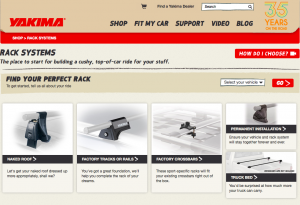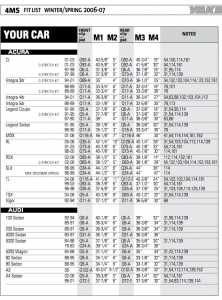Risky business: The challenge of content silos
At Information Development World, I delivered a keynote on the challenges of content silos. The silo problem emerged as a major theme of the conference.
Presenters such as Janice Zdankus of Hewlett-Packard provided data that explains how silos affect customer experience and how those negative experiences in turn result in lost revenue. My job was to tell the story of bad customer experience.
Buying a roof rack
Yakima has a wonderful product configurator. You tell Yakima the make, model, and year of your car, along with the type of item you want to convey (bikes, kayaks, skis?), and it tells you exactly what components you need for your car.
And of course there is a big shiny Buy button at the end of the process.
After you buy the rack, the pieces show up at your door, and it appears that Yakima’s interest in a delightful customer experience ends. After all, they have my money. The product installation is ugly and requires a tedious lookup in other documents.
The contrast with the sales content is quite marked.
Yakima does provide a web-based lookup tool for the needed measurements, but I did not see a reference to this utility in any of the documents I received with the roof rack parts.
Obvious bad service
Another customer experience example comes from Comcast (of course). In a lengthy and entertaining rant, Staci Huckeba has this to say:
Nobody in the “the customer has a problem department” can do everything like they can in the “the customer wants to buy something department.”
Broken web sites
Recently, the Internet at our office stopped working. We tried the usual, obvious stuff (reboot the router), but that didn’t work. So the next step was to see whether the provider (Windstream) was having a wider outage. It turns out that finding the network status/outage reports on Windstream’s site was nearly impossible. A simple Google search eventually revealed that Windstream does in fact have an outage page, but it was thoroughly hidden from the normal site navigation.
The problem here is that the web site is intended as a sales tool and not as a support tool. Even though Windstream has a “support” area on its web site, it does not provide easy access to the outage information.
In the recording, available in a link at the end of this article, I provide some more details and examples of cases where content silos result in inconsistent and generally infuriating customer experience.
What to do
I have three major recommendations to address the content silo problem:
- Integrated content development and delivery
- Break down the organizational barriers
- Break down presentational barriers
These are simple concepts, but executing them well is of course challenging. If you need help, contact us.
The recording of the session is available on the Content Wrangler’s BrightTALKchannel. Janice Zdankus opens the session, followed by Lee LeFever of Common Craft, and then my part starts at around 72 minutes.





2 comments on “Risky business: The challenge of content silos”